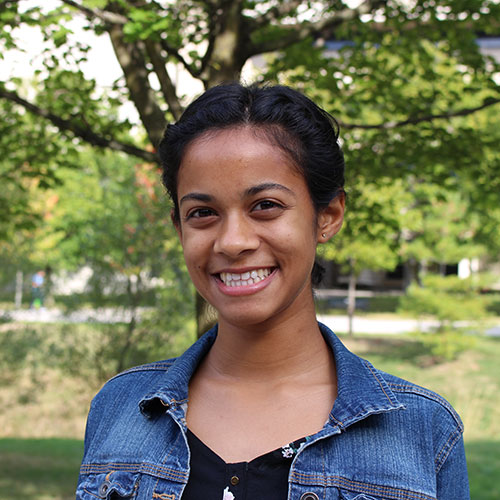 This blog post was written by Aliya during her 4th year in the Environmental Management stream.
This blog post was written by Aliya during her 4th year in the Environmental Management stream.

Aliya and Celeena at the EcoCampus
I have wanted to visit the Las Nubes EcoCampus since I was in grade 12 deciding which university I wanted to attend. In fact, the Semester Abroad program is one of the main reasons why I chose York and the Environmental Studies program. When choosing courses for the semester, I did not hesitate to sign up for the Natural History course (ENVS 4120) with Prof. Leesa Fawcett and the Protected Area Management course (ENVS 4446) with Prof. Sheila Colla. I had heard a lot of great things about these courses in the past, I was very passionate about both subjects, and they fit perfectly under the required Environmental Management courses I needed to complete my degree. It ended up being an amazing experience! Below are some of my favourite aspects of the Las Nubes Ecocampus and the Semester Abroad Program:
Los Cusingos
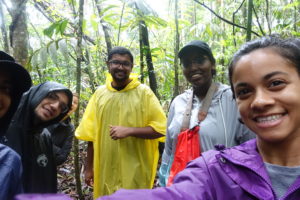
Aliya and her friends at Los Cusingos
Los Cusingos is a conservation park located in Quizarrá in the Alexander Skutch biological corridor. It was about a 20 minute bus ride from the EcoCampus, so it was very easy quick to get to. I visited this site for both the Natural History and Protected Area Management courses and loved it just as much the second time around! Each time I visited the park, we looked at it from a different lens. In Natural History, we focused more on the tropical ecosystem, how its ethology (The scientific study of animal behavior) shapes the park and how its history has an impact on it overall. In Protected Area Management, we focused more on the history of Alexander Skutch and his role as an ecologist along with how his efforts contributed to conservation of the space and other places in Costa Rica.
We also did a lot of hiking in the park which allowed us to see some cool features:
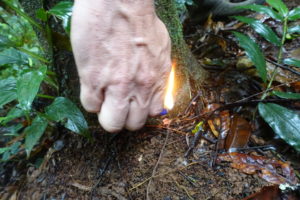
Kerosene tree being lit with a lighter
- The kerosene tree, which is a tree whose sap is used to make fuel.
- The milk tree, which is a tree that produces a white, milky fluid in its trunk. It sort of reminds me of coconut milk and when ingested, it aids in calming digestive distress.
- A Brazilian wandering spider’s nest, which was definitely the most deadly thing I came into contact with throughout the whole trip. These spiders are known to be the most venomous spiders in the world and they can jump up to one meter. I only got to see the nest up close, but it was still quite nerve-wracking! It was nestled under a leaf just at the beginning of the trail in a cocoon of spider silk protecting its eggs. This is one reason why we were often warned not to touch things without checking first, because you never know who’s home you’re messing with!
-
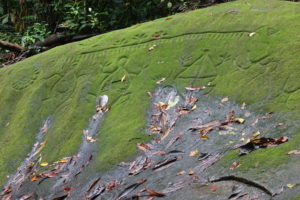
Indigenous Petroglyphs
Indigenous Petroglyphs, which are thought to have been made by an early indigenous tribe local to that part of Costa Rica. These were the most mysterious, but interesting things I saw at Los Cusingos. The petroglyphs were carved into a rock that is assumed to be around a thousand years ago. Some of the petroglyphs include: a human footprint, a pumas’s footprint, the sun, a turtle and the water. However, these are all just interpretations and no one actually knows what they mean.
La Cusinga

Dinner time at La Cusinga
La Cusinga was a lodge that we stayed in for part of the Natural History course. It was like a hotel; We stayed overnight sleeping in bunk beds and were served breakfast, lunch and dinner each day. The food was AMAZING and to be honest, it was something I always caught myself thinking about. Don’t worry, I’ll talk about Costa Rican cuisine in a later blog post! The lodge was also shaped liked a whale’s tail. I also really enjoyed the view of the lodge which looked out into the Pacific Ocean. Their beach is where leatherback sea turtles would lay their eggs and hammerhead sharks would come to have their babies. Most of these occurrences happen at night, so I wasn’t lucky enough to see it happen. Plus, I’m sure those species appreciate some privacy when it comes to things like that.
Next, I really enjoyed the night hike we did here which was an easier hike than I expected. When I first heard about doing a night hike, I thought it was going to be something like hiking on a trail in the middle of the rainforest on a dark and stormy night. But at La Cusinga, it was quite the opposite. On a calm night after dinner, with the moon bright in the sky, a handful of my peers and I went on the night hike with guides who worked at the lodge showing us how active some of the local wildlife can be at nighttime
Quizarrá School
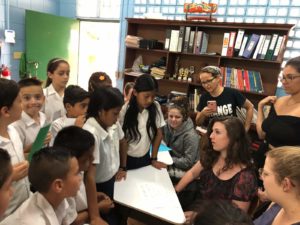
Environmental Studies students teaching at Quizarrá
Quizarrá is a local school that is unfortunately underfunded. Because of this, the community comes together to support the school such as the mothers of students helping clean and maintain the property because the school can’t afford caretakers. As well, there aren’t enough teachers, so the principal teaches certain subjects to many of the students.

A group picture at Quizarrá School
We visited Quizarrá to help support these students’ education. Prior to going to the school, everyone in my class drew a picture of a native species to Costa Rica that they were studying and wrote a riddle on the back of the picture that would lead the kids into figuring out what the species was. Later, Gretel, one of the EcoCampus staff members, translated our riddles into Spanish so the kids could understand them. Then we would read the riddle out for the students (In Spanish!) and have them guess what they thought the answer was. Coincidentally, my species was the leatherback sea turtle! I thought this activity was very engaging. The kids were having fun and in the end, each student got a hand drawn picture of a species native to their country with some basic information about it. Their eagerness for more riddles and the smiles on their face just filled my heart with joy! I knew that they were having fun and I was part of the reason why, which was very rewarding.
Downtime at the EcoCampus
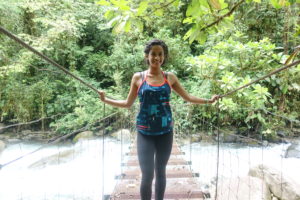
Aliya down by the river at the Eco campus
There were so many things that I loved about this trip that I can’t possibly name them all. However, just being at the EcoCampus was one of my favourite parts of the Semester Abroad. Whether it’s the waterfall and river that was our backyard or the acres among acres of untouched rainforest, the EcoCampus and the area around it is a space that moved me. Every morning, showing up to the EcoCampus was like waking up on Christmas morning - you never knew what you were going to get. Were you going to hear a toucan’s call? See a coral snake? Watch the clouds pour over the canopy that looked like the never ending green wall in front of you? All of the sights, sounds and scenery at the EcoCampus were a treat and I am so lucky to have called that place my home for a semester.
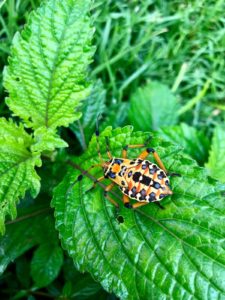
A beetle found on the EcoCampus
While we still had class and daily activities, the courses are designed to ensure there is down time: time to relax, unwind and just take everything in. I used this time to my full advantage. I was always down by the river swimming around the rough white water or taking pictures at the waterfall. If I wasn’t outside on my downtime (which was rare), I would be up at the top of the EcoCampus looking out from the viewing point, trying to spot all the places I could see nearby.
Among the natural beauty and wildlife around the EcoCampus, indoors was pretty fun too! I got to know my classmates very well, talk to Gretel who was always preparing the most delicious and refreshing snacks for us and looking up the species of insect I just found in one of the many field guides. I love the EcoCampus and one day I will be back, whether it’s to visit, do my masters, who knows? Until next time, Pura vida!

